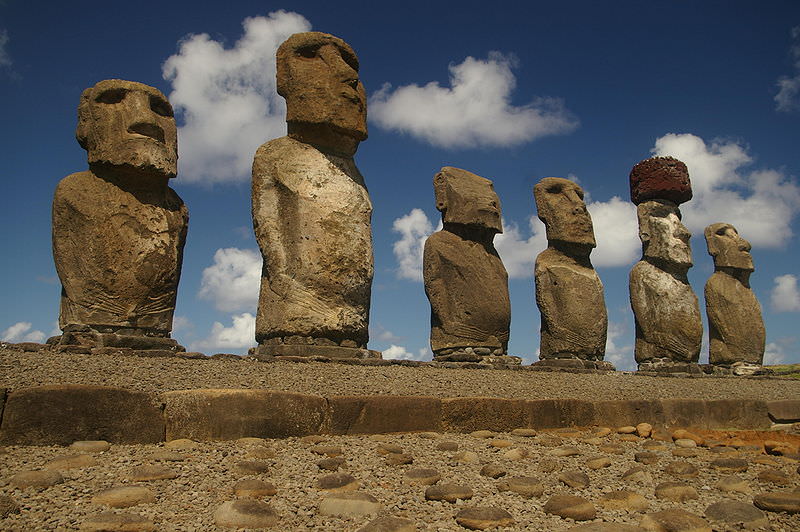[/caption]
A group of astronomers are now on the mysterious Easter Island, one of the few solid places to stand on Earth where a total solar eclipse will be visible on July 11, 2010. The majority of the eclipse's path is over the ocean, so this will be one of the least observed eclipses ever. "This is one of the most interesting things that is possible for anyone on Earth to see in one of the most interesting places on the Earth that people can go," said Jay Pasachoff from Williams College, who is the Chair of the International Astronomical Union's Working Group on Eclipses. This will be his 51st eclipse.
[caption id="attachment_68142" align="aligncenter" width="307" caption="Williams astronomer Jay Pasachoff during the partial phase of the March 29, 2006 solar eclipse. Photo by Anna Tsykalova."]
[/caption] While the eclipse is thousands of miles long in its is path of totality on Earth, it is just a few hundred miles wide. It will pass through French Polynesia on the Cook Islands, but, Pasachoff said, it doesn't go through any of the main islands. "It misses Tahiti, but there are some atolls off the side of the path, and some eclipse scientists and ecotourists will be on cruise ships that are going into the path of totality. There will also be a group on an airplane observing the eclipse and we hope to compare all the other observations with the ones we get from Easter Island," he said.
Easter Island is 4023 km (2,500 miles) west of Chile, and is famous for the Moai, giant statutes that were left by a Polynesian culture that mysteriously disappeared. But while the statues' constant gaze look outward, all human eyes will be on the skies on July 11.
"The actual four minutes and forty-five seconds of totality that we are scheduled to have at Easter Island will be very exciting, as the last sliver of the sun is covered we can then take off the protective filters we've been using," Pasachoff said, "and look at the next few minutes without any protection because the solar corona is about the same brightness as the full moon and is equally safe to look at. In fact we've been having a debate recently about whether we can get a very brief warning on the so-called eclipse glasses that many people use because those glasses are only for when any of the everyday sun is visible. They are so dense that they block the solar corona entirely, and the few people who don't understand what is going on enough to take those glasses off during totality miss the whole event. There are people who have missed past eclipses by not knowing they had to take their glasses off."
Pasachoff is joined by Professor Marek Demianski and two students. They will be carrying out high-resolution imaging to look for motions in the corona and to follow the varying magnetic-field configuration in the solar-corona as a function of the solar-activity cycle. Though the sunspot cycle remains in an extreme low, some other indications of solar activity have been increasing and we are eager to see the condition of the low and middle corona. They expect to see motions at least in polar plumes.
Also, they will be using the images to fill in gaps between the observations of the corona on the solar disk taken with NASA's new Solar Dynamics Observatory and the observations of the outer corona taken with the Naval Research Laboratory's coronagraph on the Solar and Heliospheric Observatory. Pasachoff and his team have contributed to similar images for the past several eclipses but now will have the improved SDO images as part of their montage. Several of the cameras will be computer controlled using software called Solar Eclipse Maestro written by Xavier Jubier of France.
Universe Today hopes to talk with Pasachoff after the eclipse to hear about his experiences.
The Williams College team is accompanied by a documentary crew filming for National Geographic Channel, and their activities will be covered in a special program entitled Easter Island Eclipse partly pre-recorded and partly expected to have new eclipse footage that will air on the National Geographic Channel on the evening of July 11th, at 11 pm.
Here are some resource Pasachoff provided for the eclipse:
On Sunday, July 11th: total solar eclipse on Easter Island (same time zone as Mountain Time in the US) Partial eclipse begins 12:40:36 Altitude of Sun: 40° Totality begins 14:08:30 Altitude of Sun: 40° Totality ends 14:13:10 Altitude of Sun: 39° Partial eclipse ends 15:34:16 Altitude of Sun: 32° Duration of totality: 4 minutes and 40 seconds
Times in UT: 18:40 UT 1st contact 20:08 UT 2nd contact: total eclipse begins 20:13 UT 3rd contact: total eclipse ends
His eclipse site for the International Astronomical Union
Google maps by Xavier Jubier and Fred Espenak
Espenak's NASA Website, with maps and details
An interactive map
An animation of eclipse phenomena
Also, Pasachoff will talk about the eclipse on the
July 10 365 Days of Astronomy podcast.
Here's a link to USTREAM channel of the eclipse.
Update: I just received a note from Robin Zimmerman at DISH Network, and for those of you who have the DISH Network, there is a special channel, DishEARTH, Ch. 287, that features live 24/7 views of the earth from space and this Sunday the eclipse be shown. Robin said their network will allow people in the US to see the phenomena, live.
And here's a video from National Geographic:
 Universe Today
Universe Today
